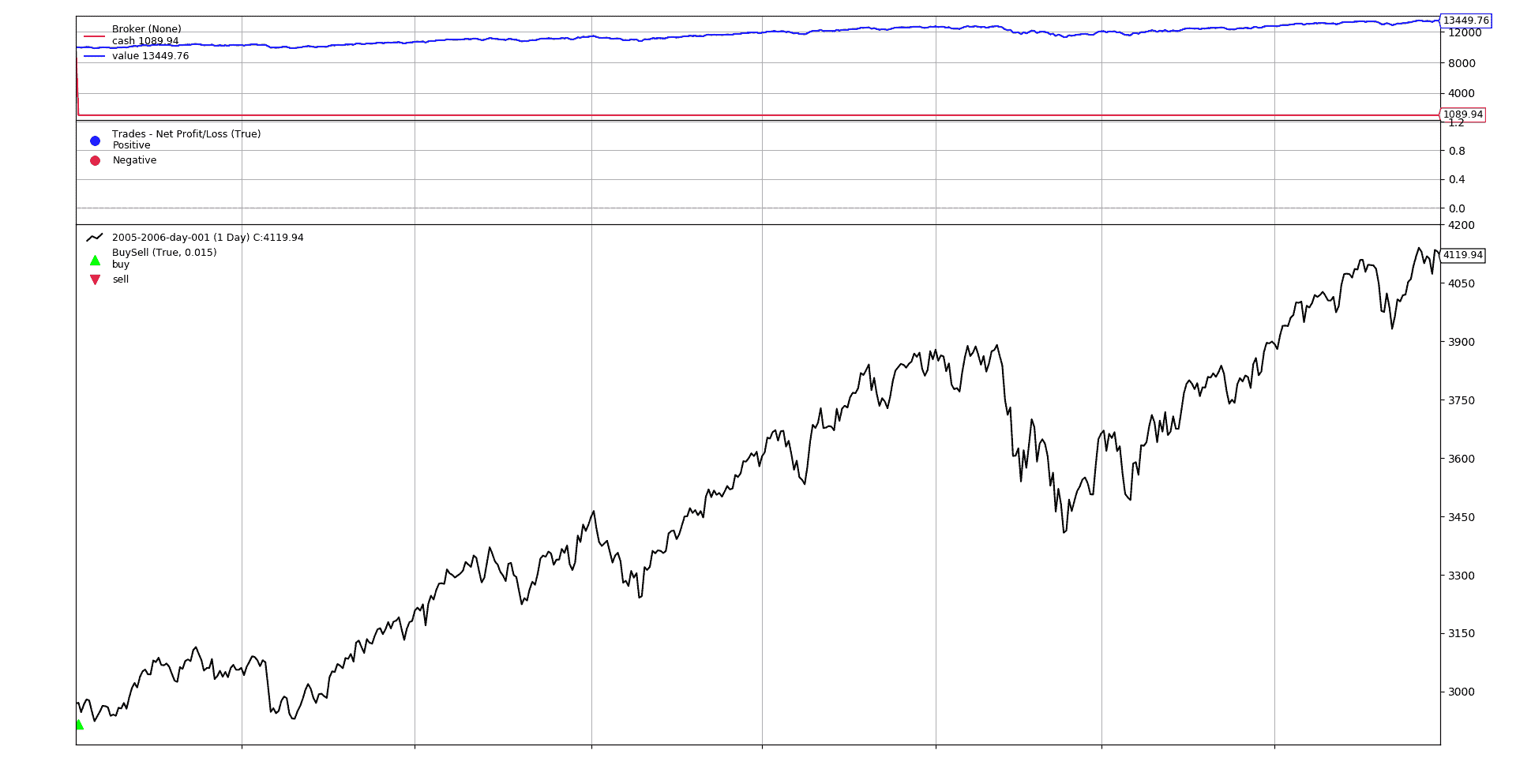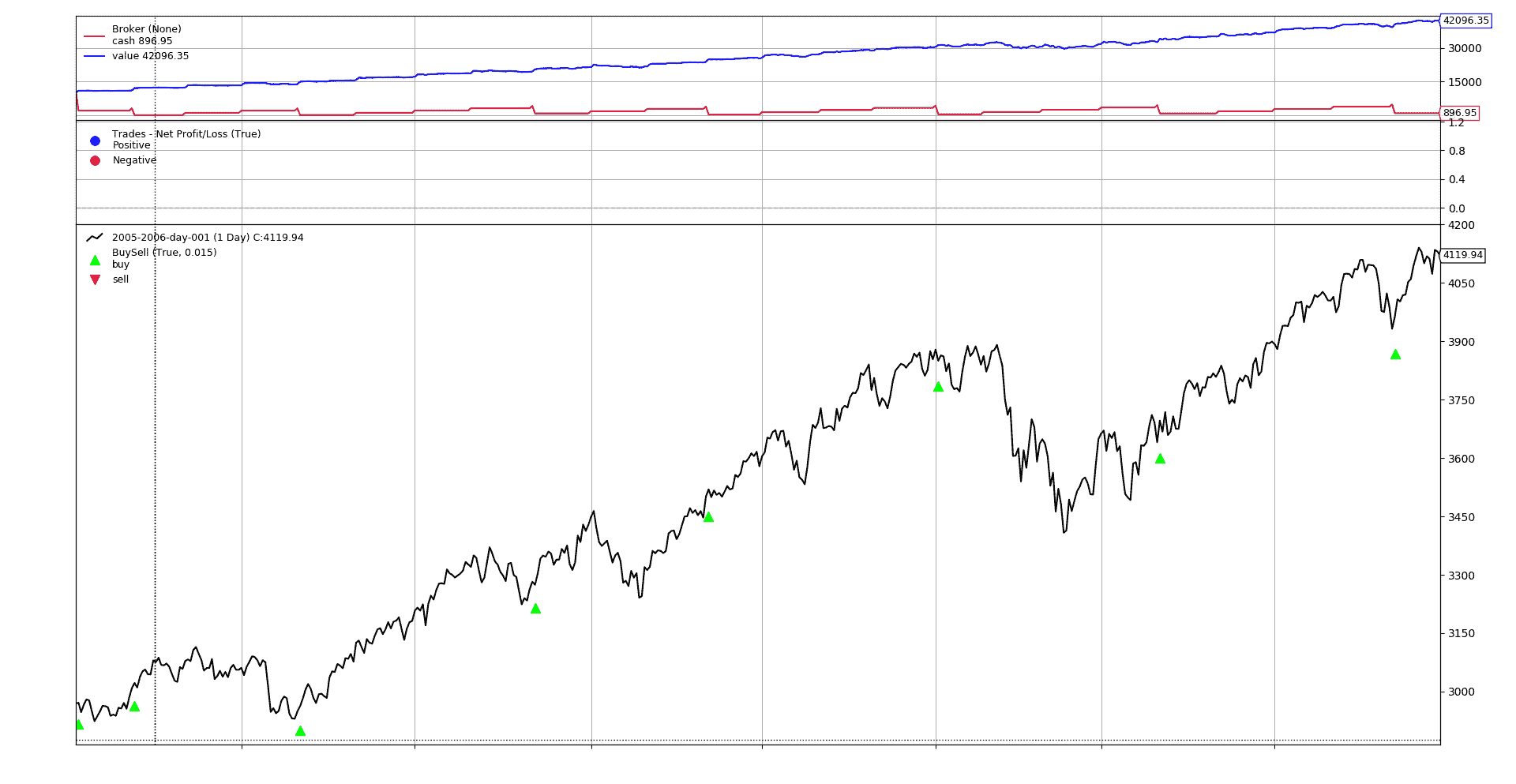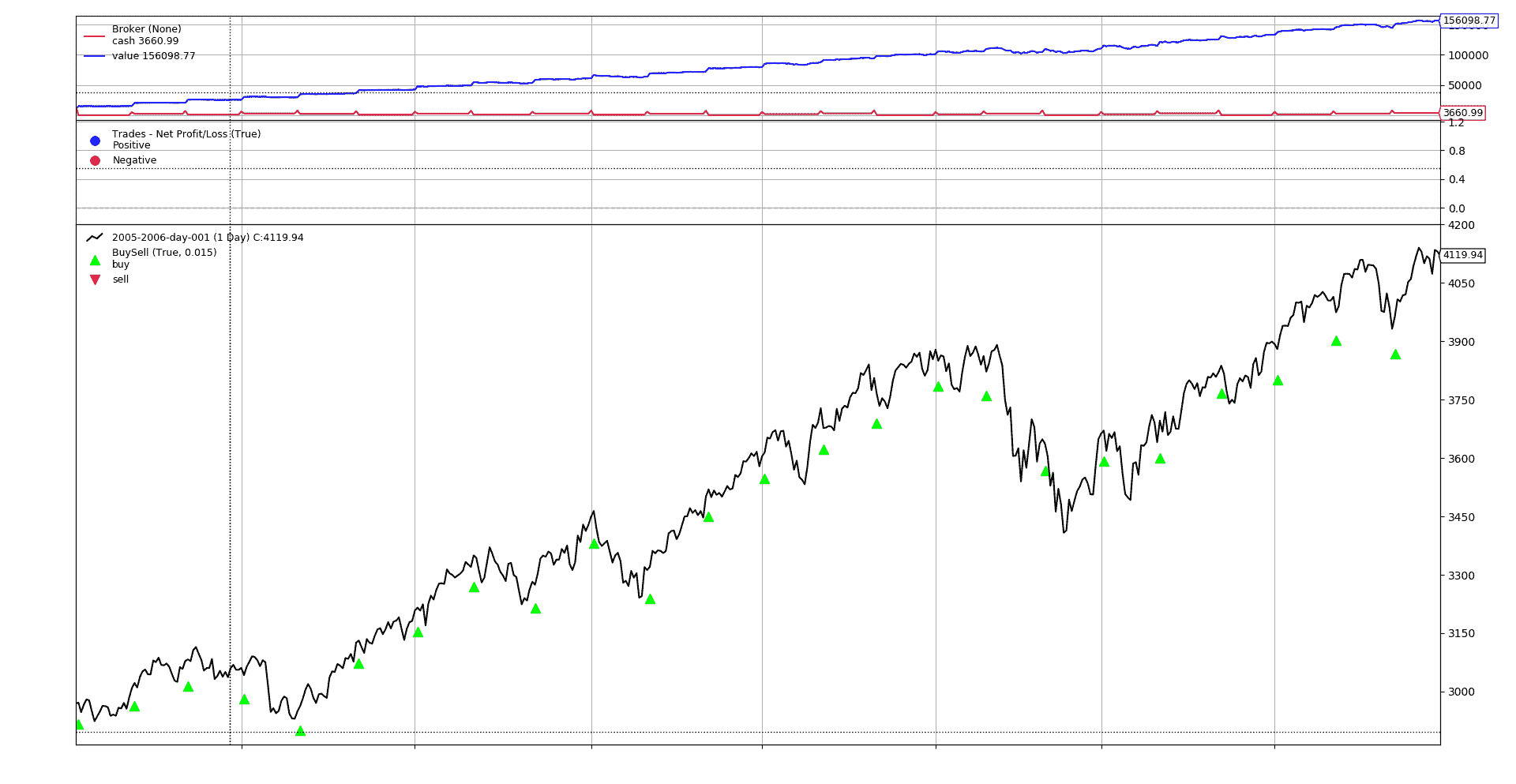用反向交易者买入并持有
原文: https://www.backtrader.com/blog/2019-06-13-buy-and-hold/buy-and-hold/
这有时是用于测试给定策略性能的基线之一,即:“如果精心编制的逻辑无法击败简单的买入和持有方法,则该策略可能一文不值”
一个简单的“买入并持有”策略,只需使用第一个输入数据点买入,并查看最后一个数据点的投资组合价值。
提示
下面的代码片段放弃了导入和设置样板。最后提供了完整的脚本。
近距离欺骗
在许多情况下,像买入并持有这样的方法并不意味着产生订单执行和价格匹配的精确复制。它是关于评估大量数据的。这就是为什么反向交易者中的违约经纪人cheat-on-close模式将被激活。这意味着
-
由于只会发出
Market订单,因此将按照当前close价格执行。 -
考虑到当交易逻辑(在本例中为
close提供价格时,该价格已消失。它可能在一段时间内可用,也可能在一段时间内不可用,实际上无法保证针对它执行。
买了就忘了
class BuyAndHold_1(bt.Strategy):
def start(self):
self.val_start = self.broker.get_cash() # keep the starting cash
def nextstart(self):
# Buy all the available cash
size = int(self.broker.get_cash() / self.data)
self.buy(size=size)
def stop(self):
# calculate the actual returns
self.roi = (self.broker.get_value() / self.val_start) - 1.0
print('ROI: {:.2f}%'.format(100.0 * self.roi))
class BuyAndHold_1(bt.Strategy):
def start(self):
self.val_start = self.broker.get_cash() # keep the starting cash
def nextstart(self):
# Buy all the available cash
self.order_target_value(target=self.broker.get_cash())
def stop(self):
# calculate the actual returns
self.roi = (self.broker.get_value() / self.val_start) - 1.0
print('ROI: {:.2f}%'.format(100.0 * self.roi))
这里发生了以下情况:
-
一项进入市场的单一长期操作正在发布。或者
-
buy和size的手动计算所有可用的
cash用于购买固定数量的资产单位。请注意,它被截断为一个int。这适用于股票、期货等。
或
order_target_value并让系统知道我们想要使用所有的现金。该方法将负责自动计算大小。- 在
start方法中,初始金额的现金被保存
-
-
在
stop方法中,使用投资组合的现值和初始现金金额计算收益
笔记
在反向交易者中,当数据/指标缓冲区可以传递时,nextstart方法被精确地调用一次。默认行为是将工作委托给next。但因为我们想购买一次并使用第一个可用数据,所以这是正确的购买点。
提示
由于只考虑了1数据馈送,因此无需指定目标数据馈送。系统中的第一个(也是唯一一个)数据馈送将用作目标。
如果存在多个数据馈送,则可以使用命名参数data选择目标,如中所示
self.buy(data=the_desired_data, size=calculated_size)
下面的示例脚本可以按如下方式执行
$ ./buy-and-hold.py --bh-buy --plot
ROI: 34.50%
$ ./buy-and-hold.py --bh-target --plot
ROI: 34.50%
两者的图形输出相同
再买再买
但是一个真正的普通人通常有一份天的工作,并且每个月都可以向股市投入大量资金。这个人不受趋势、技术分析等的困扰。唯一真正关心的是在每月的 1st日将资金投入市场。
罗马人给我们留下了一个日历,日历上的月份在天数上有所不同(28、29、30、31),考虑到非交易日,我们不能确定使用以下简单方法:
- 购买每个X天
需要使用一种方法来识别当月的第一个交易日。这可以通过反向交易者中的计时器完成
笔记
下面的示例中仅使用order_target_value方法。
class BuyAndHold_More(bt.Strategy):
params = dict(
monthly_cash=1000.0, # amount of cash to buy every month
)
def start(self):
self.cash_start = self.broker.get_cash()
self.val_start = 100.0
# Add a timer which will be called on the 1st trading day of the month
self.add_timer(
bt.timer.SESSION_END, # when it will be called
monthdays=[1], # called on the 1st day of the month
monthcarry=True, # called on the 2nd day if the 1st is holiday
)
def notify_timer(self, timer, when, *args, **kwargs):
# Add the influx of monthly cash to the broker
self.broker.add_cash(self.p.monthly_cash)
# buy available cash
target_value = self.broker.get_value() + self.p.monthly_cash
self.order_target_value(target=target_value)
def stop(self):
# calculate the actual returns
self.roi = (self.broker.get_value() / self.cash_start) - 1.0
print('ROI: {:.2f}%'.format(self.roi))
在start阶段,添加了一个计时器
# Add a timer which will be called on the 1st trading day of the month
self.add_timer(
bt.timer.SESSION_END, # when it will be called
monthdays=[1], # called on the 1st day of the month
monthcarry=True, # called on the 2nd day if the 1st is holiday
)
-
将在会话结束时调用的计时器(
bt.timer.SESSION_END笔记
对于日常酒吧来说,这显然是不相关的,因为整个酒吧都是一次性交付的。
-
计时器只列出一个月中必须调用计时器的日期
1 -
如果
1日恰好是非交易日,monthcarry=True确保计时器仍将在当月的第一个交易日调用。
在notify_timer方法期间接收到的计时器,被覆盖以执行市场操作。
def notify_timer(self, timer, when, *args, **kwargs):
# Add the influx of monthly cash to the broker
self.broker.add_cash(self.p.monthly_cash)
# buy available cash
target_value = self.broker.get_value() + self.p.monthly_cash
self.order_target_value(target=target_value)
提示
请注意,购买的不是月现金流入,而是账户的总价值,包括当前投资组合,再加上我们增加的资金。原因
-
可能需要消耗一些初始现金
-
每月的运营可能不会消耗所有的现金,因为一个月可能不足以购买股票,而且收购股票后会有一段时间休息
在我们的示例中,实际上是这样的,因为默认的每月现金流入量为
1000,并且资产的价值超过3000 -
如果目标是可用现金,这可能小于实际价值
处决
$ ./buy-and-hold.py --bh-more --plot
ROI: 320.96%
$ ./buy-and-hold.py --bh-more --strat monthly_cash=5000.0
ROI: 1460.99%
起泡的藤壶!!!默认1000货币单位的ROI为320.96%,而5000货币单位的ROI更高1460.99%。我们可能发现了一台印钞机。。。
- 我们每个月增加的钱越多。。。我们赢的越多。。。不管市场做什么。
当然不是。。。
stop期间self.roi中存储的计算不再有效。只需向经纪人简单地增加现金,就可以改变规模(即使这笔钱没有用于任何用途,也可以算作增量)
1000 货币单位的图形输出
请注意市场中实际操作之间的间隔,因为1000货币单位不足以购买1单位的资产,必须累积货币,直到操作成功。
5000 货币单位的图形输出
在这种情况下,5000货币单位始终可以购买1单位的资产,并且每个月都会进行市场操作。
购买和购买更多的绩效跟踪
如上所述,当系统中增加(有时从中取出)资金时,必须以不同的方式衡量性能。没有必要发明任何东西,因为它是很久以前发明的,它是为基金管理所做的。
-
设置
perf_value作为跟踪绩效的参考。通常情况下,这将100 -
使用该绩效值和现金初始金额,计算出一个数字
shares,即:shares = cash / perf_value -
无论何时向系统中添加或从系统中删除现金,
shares的数量都会发生变化,但perf_value保持不变。 -
现金有时会进行投资,每日的
value会更新为perf_value = portfolio_value / shares中的内容
通过这种方法,可以计算实际性能,并且与系统中的现金添加/提取无关。
幸运的是,反向交易者已经可以自动完成所有这些。
class BuyAndHold_More_Fund(bt.Strategy):
params = dict(
monthly_cash=1000.0, # amount of cash to buy every month
)
def start(self):
# Activate the fund mode and set the default value at 100
self.broker.set_fundmode(fundmode=True, fundstartval=100.00)
self.cash_start = self.broker.get_cash()
self.val_start = 100.0
# Add a timer which will be called on the 1st trading day of the month
self.add_timer(
bt.timer.SESSION_END, # when it will be called
monthdays=[1], # called on the 1st day of the month
monthcarry=True, # called on the 2nd day if the 1st is holiday
)
def notify_timer(self, timer, when, *args, **kwargs):
# Add the influx of monthly cash to the broker
self.broker.add_cash(self.p.monthly_cash)
# buy available cash
target_value = self.broker.get_value() + self.p.monthly_cash
self.order_target_value(target=target_value)
def stop(self):
# calculate the actual returns
self.roi = (self.broker.get_value() - self.cash_start) - 1.0
self.froi = self.broker.get_fundvalue() - self.val_start
print('ROI: {:.2f}%'.format(self.roi))
print('Fund Value: {:.2f}%'.format(self.froi))
在start期间
-
资金模式被激活,默认启动值为
100.0py def start(self): # Activate the fund mode and set the default value at 100 self.broker.set_fundmode(fundmode=True, fundstartval=100.00)
在stop期间
-
资金
ROI已计算。因为起始值为100.0,所以操作比较简单py def stop(self): # calculate the actual returns ... self.froi = self.broker.get_fundvalue() - self.val_start
行刑
$ ./buy-and-hold.py --bh-more-fund --strat monthly_cash=5000 --plot
ROI: 1460.99%
Fund Value: 37.31%
在这种情况下:
-
同样令人难以置信的平原
ROI已经实现,即1460.99% -
考虑到样本数据,将其视为基金时的实际
ROI更为温和和现实37.31%。
笔记
输出图表与上一次执行相同,使用5000货币单位。
示例脚本
import argparse
import datetime
import backtrader as bt
class BuyAndHold_Buy(bt.Strategy):
def start(self):
self.val_start = self.broker.get_cash() # keep the starting cash
def nextstart(self):
# Buy all the available cash
size = int(self.broker.get_cash() / self.data)
self.buy(size=size)
def stop(self):
# calculate the actual returns
self.roi = (self.broker.get_value() / self.val_start) - 1.0
print('ROI: {:.2f}%'.format(100.0 * self.roi))
class BuyAndHold_Target(bt.Strategy):
def start(self):
self.val_start = self.broker.get_cash() # keep the starting cash
def nextstart(self):
# Buy all the available cash
size = int(self.broker.get_cash() / self.data)
self.buy(size=size)
def stop(self):
# calculate the actual returns
self.roi = (self.broker.get_value() / self.val_start) - 1.0
print('ROI: {:.2f}%'.format(100.0 * self.roi))
class BuyAndHold_More(bt.Strategy):
params = dict(
monthly_cash=1000.0, # amount of cash to buy every month
)
def start(self):
self.cash_start = self.broker.get_cash()
self.val_start = 100.0
# Add a timer which will be called on the 1st trading day of the month
self.add_timer(
bt.timer.SESSION_END, # when it will be called
monthdays=[1], # called on the 1st day of the month
monthcarry=True, # called on the 2nd day if the 1st is holiday
)
def notify_timer(self, timer, when, *args, **kwargs):
# Add the influx of monthly cash to the broker
self.broker.add_cash(self.p.monthly_cash)
# buy available cash
target_value = self.broker.get_value() + self.p.monthly_cash
self.order_target_value(target=target_value)
def stop(self):
# calculate the actual returns
self.roi = (self.broker.get_value() / self.cash_start) - 1.0
print('ROI: {:.2f}%'.format(100.0 * self.roi))
class BuyAndHold_More_Fund(bt.Strategy):
params = dict(
monthly_cash=1000.0, # amount of cash to buy every month
)
def start(self):
# Activate the fund mode and set the default value at 100
self.broker.set_fundmode(fundmode=True, fundstartval=100.00)
self.cash_start = self.broker.get_cash()
self.val_start = 100.0
# Add a timer which will be called on the 1st trading day of the month
self.add_timer(
bt.timer.SESSION_END, # when it will be called
monthdays=[1], # called on the 1st day of the month
monthcarry=True, # called on the 2nd day if the 1st is holiday
)
def notify_timer(self, timer, when, *args, **kwargs):
# Add the influx of monthly cash to the broker
self.broker.add_cash(self.p.monthly_cash)
# buy available cash
target_value = self.broker.get_value() + self.p.monthly_cash
self.order_target_value(target=target_value)
def stop(self):
# calculate the actual returns
self.roi = (self.broker.get_value() / self.cash_start) - 1.0
self.froi = self.broker.get_fundvalue() - self.val_start
print('ROI: {:.2f}%'.format(100.0 * self.roi))
print('Fund Value: {:.2f}%'.format(self.froi))
def run(args=None):
args = parse_args(args)
cerebro = bt.Cerebro()
# Data feed kwargs
kwargs = dict(**eval('dict(' + args.dargs + ')'))
# Parse from/to-date
dtfmt, tmfmt = '%Y-%m-%d', 'T%H:%M:%S'
for a, d in ((getattr(args, x), x) for x in ['fromdate', 'todate']):
if a:
strpfmt = dtfmt + tmfmt * ('T' in a)
kwargs[d] = datetime.datetime.strptime(a, strpfmt)
data = bt.feeds.BacktraderCSVData(dataname=args.data, **kwargs)
cerebro.adddata(data)
# Strategy
if args.bh_buy:
stclass = BuyAndHold_Buy
elif args.bh_target:
stclass = BuyAndHold_Target
elif args.bh_more:
stclass = BuyAndHold_More
elif args.bh_more_fund:
stclass = BuyAndHold_More_Fund
cerebro.addstrategy(stclass, **eval('dict(' + args.strat + ')'))
# Broker
broker_kwargs = dict(coc=True) # default is cheat-on-close active
broker_kwargs.update(eval('dict(' + args.broker + ')'))
cerebro.broker = bt.brokers.BackBroker(**broker_kwargs)
# Sizer
cerebro.addsizer(bt.sizers.FixedSize, **eval('dict(' + args.sizer + ')'))
# Execute
cerebro.run(**eval('dict(' + args.cerebro + ')'))
if args.plot: # Plot if requested to
cerebro.plot(**eval('dict(' + args.plot + ')'))
def parse_args(pargs=None):
parser = argparse.ArgumentParser(
formatter_class=argparse.ArgumentDefaultsHelpFormatter,
description=(
'Backtrader Basic Script'
)
)
parser.add_argument('--data', default='../../datas/2005-2006-day-001.txt',
required=False, help='Data to read in')
parser.add_argument('--dargs', required=False, default='',
metavar='kwargs', help='kwargs in key=value format')
# Defaults for dates
parser.add_argument('--fromdate', required=False, default='',
help='Date[time] in YYYY-MM-DD[THH:MM:SS] format')
parser.add_argument('--todate', required=False, default='',
help='Date[time] in YYYY-MM-DD[THH:MM:SS] format')
parser.add_argument('--cerebro', required=False, default='',
metavar='kwargs', help='kwargs in key=value format')
parser.add_argument('--broker', required=False, default='',
metavar='kwargs', help='kwargs in key=value format')
parser.add_argument('--sizer', required=False, default='',
metavar='kwargs', help='kwargs in key=value format')
parser.add_argument('--strat', '--strategy', required=False, default='',
metavar='kwargs', help='kwargs in key=value format')
parser.add_argument('--plot', required=False, default='',
nargs='?', const='{}',
metavar='kwargs', help='kwargs in key=value format')
pgroup = parser.add_mutually_exclusive_group(required=True)
pgroup.add_argument('--bh-buy', required=False, action='store_true',
help='Buy and Hold with buy method')
pgroup.add_argument('--bh-target', required=False, action='store_true',
help='Buy and Hold with order_target method')
pgroup.add_argument('--bh-more', required=False, action='store_true',
help='Buy and Hold More')
pgroup.add_argument('--bh-more-fund', required=False, action='store_true',
help='Buy and Hold More with Fund ROI')
return parser.parse_args(pargs)
if __name__ == '__main__':
run()
$ ./buy-and-hold.py --help
usage: buy-and-hold.py [-h] [--data DATA] [--dargs kwargs]
[--fromdate FROMDATE] [--todate TODATE]
[--cerebro kwargs] [--broker kwargs] [--sizer kwargs]
[--strat kwargs] [--plot [kwargs]]
(--bh-buy | --bh-target | --bh-more | --bh-more-fund)
Backtrader Basic Script
optional arguments:
-h, --help show this help message and exit
--data DATA Data to read in (default:
../../datas/2005-2006-day-001.txt)
--dargs kwargs kwargs in key=value format (default: )
--fromdate FROMDATE Date[time] in YYYY-MM-DD[THH:MM:SS] format (default: )
--todate TODATE Date[time] in YYYY-MM-DD[THH:MM:SS] format (default: )
--cerebro kwargs kwargs in key=value format (default: )
--broker kwargs kwargs in key=value format (default: )
--sizer kwargs kwargs in key=value format (default: )
--strat kwargs, --strategy kwargs
kwargs in key=value format (default: )
--plot [kwargs] kwargs in key=value format (default: )
--bh-buy Buy and Hold with buy method (default: False)
--bh-target Buy and Hold with order_target method (default: False)
--bh-more Buy and Hold More (default: False)
--bh-more-fund Buy and Hold More with Fund ROI (default: False)




